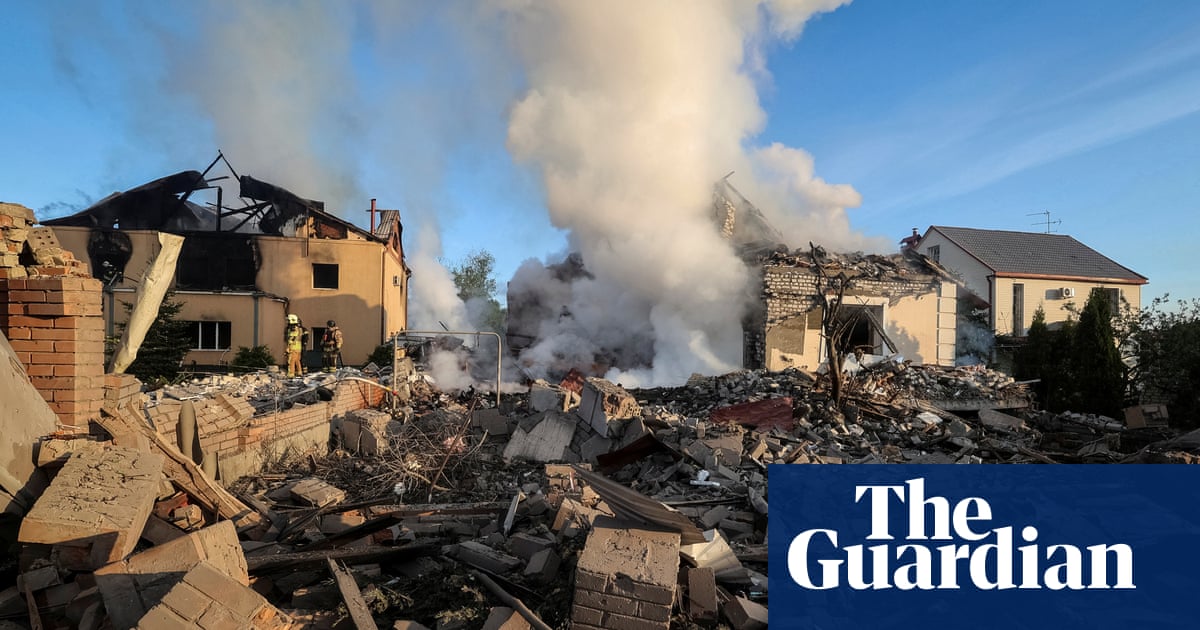


Russian forces have attacked across the Ukrainian border to the north of Kharkiv in a potential effort to open a new front in the war and intensify the pressure on Ukraine’s second city.
Ukraine’s defence ministry said there had been “an attempt by the enemy to break through our defence line using armoured vehicles” at about 5am on Friday near the town of Vovchansk, and the initial attacks had been repelled.
There were also reports of fighting in the border villages of Strilecha, Pylna and Borysivka farther west, and that Russian forces had advanced by about 1km around Vovchansk, though these could not be confirmed.
Ukraine’s president, Volodymyr Zelenskiy, said his country’s forces had been ready for the attack. “Ukraine met them there with troops – brigades and artillery,” he said at a press conference in Kyiv, though he warned that Russia could send more troops to support its fresh attack.
The influential Russian military blogger Rybar described the attack as a “reconnaissance in force” rather than a full-scale assault, and described the battle zone as being expanded to “a depth of 2-3km” in some border areas. Attacks were aimed at Ukrainian artillery points to weaken defences, the blogger added.
Russia has been gradually intensifying military operations around Kharkiv over the past month, taking advantage of limited Ukrainian air defences to bomb in and around the city in an attempt to persuade more of its 1.3 million residents to flee and turn it into an increasingly depopulated grey zone.
Kharkiv, about 20 miles south of the Russian border, firmly resisted the initial invasion in the spring of 2022. A lightning Ukrainian counteroffensive in September of that year pushed back Moscow’s forces well beyond the range of artillery fire, encouraging many more civilians to return.
Oleh Syniehubov, the governor of Kharkiv oblast, said there had been heavy Russian shelling in the border areas for the past day, and he appealed to residents around Vovchansk and Lyptsi to leave their homes. Earlier this week, Syniehubov said a buildup of Russian forces south of Belgorod had been spotted.
The Russian defence ministry did not refer to attempts to breach Ukrainian defensive lines on Friday or announce a new offensive in the Kharkiv region. But the ministry did claim to have taken two towns in the region, Kotlyarovka and Kislovka, and to have “repulsed Ukrainian counterattacks” along the frontlines as well.
Other popular Russian military bloggers corroborated reports of artillery bombardments along the border area but warned the most optimistic of Russia’s supporters against declaring victory preliminarily.
“The northern troops have been really launching the most powerful artillery and airstrikes against the enemy since yesterday evening,” wrote Starshe Eddy, who claimed without evidence that a dozen Ukrainian soldiers had been captured. While the bombardment continued, the channel added, “no one is storming Volchansk yet”.
Russia is expected to recruit additional troops this year, and Russian and Ukrainian military officials have said fighting is expected to intensify on the frontlines in May and June as Russia attempts to exploit Ukrainian weapons shortages before renewed supplies of arms from the US arrive.
Analysts say Russia, which has an estimated 500,000 soldiers in Ukraine, is able to attack in multiple locations taking advantage of an artillery overmatch estimated at anywhere between five and 10 to one as well as weak air defences.
The attacks in Kharkiv region could simply be an effort to force Ukraine to move up reserves into the region. For the moment, the main Russian offensive appears to remain concentrated in the Donbas region in south-east Ukraine, where Russian forces are attempting to seize the frontline town of Chasiv Yar.
Earlier this year the independent Russian news website Vyorstka reported that Moscow was planning to recruit as many as 300,000 soldiers in order to prepare an invasion of the Kharkiv region. The report cited sources in the Kremlin, defence ministry and regional governments, but it has not been confirmed by other outlets.
However, few believe that Kharkiv is at risk of capture without Russia pouring in massive numbers of troops to fight a highly risky battle against a hostile city. A number of analysts have said Vladimir Putin’s goal appears to be to make the city unliveable.
Putin said in a public speech in March that he would consider creating a demilitarised “‘sanitary zone’ in the territories today under the Kyiv regime”, and that the zone would have to be large enough to prevent attacks on Russian territory by foreign-supplied missiles or raiding groups. Last month, the foreign minister, Sergei Lavrov, said the city of Kharkiv would be a part of that demilitarised zone.
Before the war, Kharkiv was Ukraine’s second largest city by population, and many of the city’s residents have remained there despite Russian rocket and missile attacks aimed at destroying its infrastructure. The situation has been amplified by Russia’s use of glide bombs, which are difficult for Ukraine’s depleted air defences to intercept.